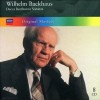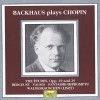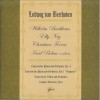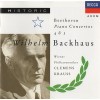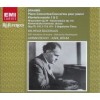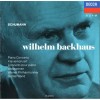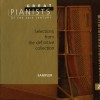| Voice/Instrument: | Pianoforte |
Biography
Wilhelm Backhaus ('Bachaus' on some record labels) (March 26, 1884 – July 5, 1969) was a German pianist and pedagogue.
Born in Leipzig, Backhaus studied at the conservatoire there with Alois Reckendorf until 1899, later taking private piano lessons with Eugen d'Albert in Frankfurt. As a boy of 9 or 10 he was taken to hear both of the Brahms piano concertos performed by d'Albert — and conducted by Brahms himself. He made his first concert tour at the age of sixteen. In 1905 he won the Anton Rubinstein Competition with Béla Bartók taking second place. He toured widely throughout his life - in 1921 he gave seventeen concerts in Buenos Aires in less than three weeks. Backhaus made his U.S. debut on January 5, 1912, as soloist in Beethoven's 5th Piano Concerto with Walter Damrosch and the New York Symphony Orchestra. In 1930 he moved to Lugano and became a citizen of Switzerland. He died in Villach in Austria where he was to play in a concert. His last recital a few days earlier in Ossiach was recorded.
Backhaus was particularly well known for his interpretations of Beethoven and romantic music such as that by Brahms. He was also much admired as a chamber musician. One of the reasons for his unique sound is his choice of a Bösendorfer piano for his performances and recordings, as opposed to the more common use of Steinway pianos.
According to some critics, Backhaus was one of the first modern artists of the keyboard (see Alfred Cortot for his antithesis) and played with a clean, spare, and objective style. In spite of this analytic approach, his performances are full of feeling. One of the first pianists to leave recordings, he had a long career on the concert stage and in the studio and left us a great legacy. He recorded virtually the complete works of Beethoven and a large quantity of Mozart and Brahms, and he was also the first to record the Chopin etudes, in 1928; this is still widely regarded as one of the best recordings (Pearl 9902 and others). Backhaus plays them smoothly and softly, overcoming their technical challenges without apparent effort. A live recording from 1953 includes seven of the Études, Op. 25 and shows the changes that occurred in his playing style over the years (Aura 119). His technical command is the same, but he is more relaxed and confident and more willing to let the music speak for itself.
His January 27, 1936 recording of Brahms's Waltzes, Op. 39, runs just over thirteen minutes. His studio recordings of the complete Beethoven sonatas, made in the 1960s, display exceptional technique for a man in his seventies (Decca 433882), as do the two Brahms concertos from about the same time (Decca 433895). His live Beethoven recordings are in some ways even better, freer and more vivid (Orfeo 300921).
His chamber music recordings include Brahms's cello sonatas, with Pierre Fournier, and Franz Schubert's Trout Quintet with the International Quartet and Claude Hobday.
The Times praised Backhaus in its 1969 obituary for having upheld the classical German music tradition of the Leipzig Conservatory. His phenomenal transposing powers spawned many anecdotes: finding the piano a semitone too low at a rehearsal of Grieg's A minor Concerto, he simply played in B flat minor — and then in A minor at the concert, after the instrument had been correctly tuned.
Backhaus was quick to recognize the importance of the gramophone. His July 15, 1909 somewhat abridged recording of the Grieg Concerto was not only the first recording of that work, but the first time any concerto had ever been recorded. Later, on January 5, 1928, he made the first complete set of recordings of the Chopin études. At his death, Backhaus was just completing his second complete Beethoven sonata cycle. All that was missing was the Hammerklavier Sonata — when, according to the Beethoven specialist Stephen Kovacevich, Wilhelm Backhaus was the only pianist to have really understood it. (Excerpts from the book/guide to the “Great Pianists of the 20th Century”, published and © in 1998 by the Philips Music Group).
Compositions
Discography
Composers' compositions
Ludwig van Beethoven
Beethoven Symphonies № 2, 3, 5 & 7 • Piano Concerto № 4 • Overtures. KnappertsbuschSymphony / Symphonic music





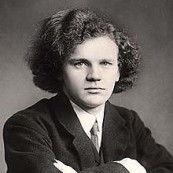
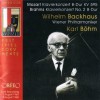


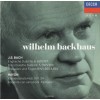
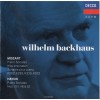


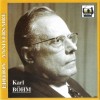
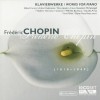


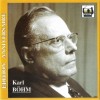
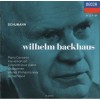
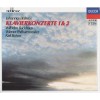
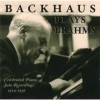

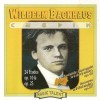

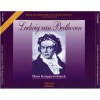
![Beethoven - Sonatas 14&29 - Backhaus [Carnegie Hall]](http://static.classicalm.com/repository/composition-cover/small/24523-img1435322298362153.jpg)

